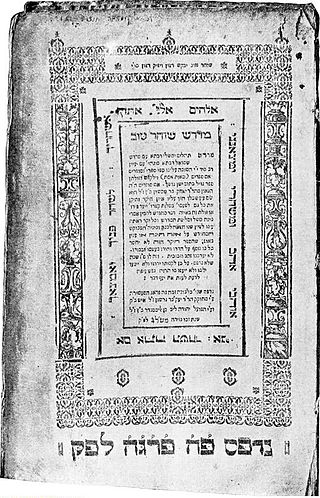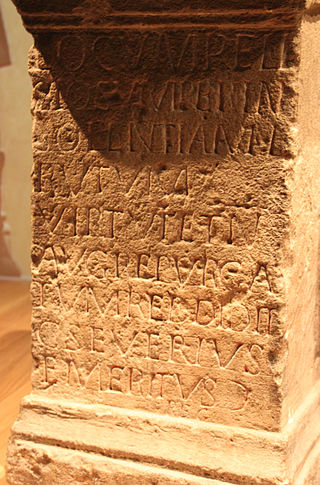
Midrash is expansive Jewish Biblical exegesis using a rabbinic mode of interpretation prominent in the Talmud. The word itself means "textual interpretation", "study", or "exegesis", derived from the root verb darash (דָּרַשׁ), which means "resort to, seek, seek with care, enquire, require".
Philology is the study of language in oral and written historical sources. It is the intersection of textual criticism, literary criticism, history, and linguistics with strong ties to etymology. Philology is also defined as the study of literary texts and oral and written records, the establishment of their authenticity and their original form, and the determination of their meaning. A person who pursues this kind of study is known as a philologist. In older usage, especially British, philology is more general, covering comparative and historical linguistics.

A symbol is a mark, sign, or word that indicates, signifies, or is understood as representing an idea, object, or relationship. Symbols allow people to go beyond what is known or seen by creating linkages between otherwise very different concepts and experiences. All communication is achieved through the use of symbols. Symbols take the form of words, sounds, gestures, ideas, or visual images and are used to convey other ideas and beliefs. For example, a red octagon is a common symbol for "STOP"; on maps, blue lines often represent rivers; and a red rose often symbolizes love and compassion. Numerals are symbols for numbers; letters of an alphabet may be symbols for certain phonemes; and personal names are symbols representing individuals.
-logy is a suffix in the English language, used with words originally adapted from Ancient Greek ending in -λογία (-logía). The earliest English examples were anglicizations of the French -logie, which was in turn inherited from the Latin -logia. The suffix became productive in English from the 18th century, allowing the formation of new terms with no Latin or Greek precedent.

Hermeneutics is the theory and methodology of interpretation, especially the interpretation of biblical texts, wisdom literature, and philosophical texts. As necessary, hermeneutics may include the art of understanding and communication.

Wyrd is a concept in Anglo-Saxon culture roughly corresponding to fate or personal destiny. The word is ancestral to Modern English weird, whose meaning has drifted towards an adjectival use with a more general sense of "supernatural" or "uncanny", or simply "unexpected".

Exegesis is a critical explanation or interpretation of a text. The term is traditionally applied to the interpretation of Biblical works. In modern usage, exegesis can involve critical interpretations of virtually any text, including not just religious texts but also philosophy, literature, or virtually any other genre of writing. The phrase Biblical exegesis can be used to distinguish studies of the Bible from other critical textual explanations.
Tafsir refers to exegesis, usually of the Quran. An author of a tafsir is a mufassir. A Quranic tafsir attempts to provide elucidation, explanation, interpretation, context or commentary for clear understanding and conviction of God's will in Islam.
Etymology is the scientific study of the origin and evolution of a word's semantic meaning across time, including its constituent morphemes and phonemes. It is a subfield of historical linguistics, philology, and semiotics, and draws upon comparative semantics, morphology, pragmatics, and phonetics in order to construct a comprehensive and chronological catalogue of all meanings that a morpheme, phoneme, word, or sign has carried across time.
The Greek language has contributed to the English lexicon in five main ways:
Folk etymology – also known as (generative) popular etymology, analogical reformation, (morphological)reanalysis and etymological reinterpretation – is a change in a word or phrase resulting from the replacement of an unfamiliar form by a more familiar one through popular usage. The form or the meaning of an archaic, foreign, or otherwise unfamiliar word is reinterpreted as resembling more familiar words or morphemes.

The Sator Square is a two-dimensional acrostic class of word square containing a five-word Latin palindrome. The earliest squares were found at Roman-era sites, all in ROTAS-form, with the earliest discovery at Pompeii. The earliest square with Christian-associated imagery dates from the sixth century. By the Middle Ages, Sator squares had been found across Europe, Asia Minor, and North Africa. In 2022, the Encyclopedia Britannica called it "the most familiar lettered square in the Western world".
Allegorical interpretation of the Bible is an interpretive method (exegesis) that assumes that the Bible has various levels of meaning and tends to focus on the spiritual sense, which includes the allegorical sense, the moral sense, and the anagogical sense, as opposed to the literal sense. It is sometimes referred to as the quadriga, a reference to the Roman chariot that was drawn by four horses.
Fabius Planciades Fulgentius was a Latin writer of late antiquity. Four extant works are commonly attributed to him, as well as a possible fifth which some scholars include in compilations with much reservation. His mythography was greatly admired and highly influential throughout much of the medieval period, though less influential today.
The historical-grammatical method is a modern Christian hermeneutical method that strives to discover the biblical authors' original intended meaning in the text. According to the historical-grammatical method, if based on an analysis of the grammatical style of a passage, it appears that the author intended to convey an account of events that actually happened, then the text should be taken as representing history; passages should only be interpreted symbolically, poetically, or allegorically if to the best of our understanding, that is what the writer intended to convey to the original audience. It is the primary method of interpretation for many conservative Protestant exegetes who reject the historical-critical method to various degrees, in contrast to the overwhelming reliance on historical-critical interpretation in biblical studies at the academic level.
Pardes (פרד"ס) is a Kabbalistic theory of Biblical exegesis first advanced by Moses de León, adapting the popular "fourfold" method of medieval Christianity. The term, sometimes also rendered PaRDeS, means "orchard" when taken literally, but is used in this context as a Hebrew acronym formed from the initials of the following four approaches:
Rebracketing is a process in historical linguistics where a word originally derived from one set of morphemes is broken down or bracketed into a different set. For example, hamburger, originally from Hamburg+er, has been rebracketed into ham+burger, and burger was later reused as a productive morpheme in coinages such as cheeseburger. It is usually a form of folk etymology, or may seem to be the result of valid morphological processes.
Charisma is a personal quality of presence or charm that other people find psychologically compelling. In the fields of sociology and political science, psychology and management the term charismatic describes a type of leadership. In Christian theology, the term charisma appears as the Spiritual gift (charism) which is an endowment with an extraordinary power given by the Holy Spirit.

The Latin term religiō, the origin of the modern lexeme religion, is of ultimately obscure etymology. It is recorded beginning in the 1st century BC, i.e. in Classical Latin at the end of the Roman Republic, notably by Cicero, in the sense of "scrupulous or strict observance of the traditional cultus". In classic antiquity, it meant conscientiousness, sense of right, moral obligation, or duty towards anything and was used mostly in secular or mundane contexts. In religious contexts, it also meant the feelings of "awe and anxiety" caused by gods and spirits that would help Romans "live successfully".